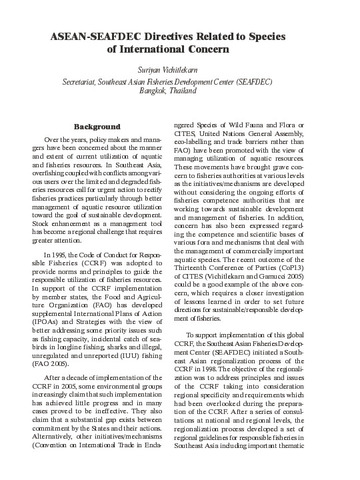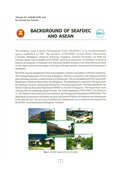Establishment of Marine Refugia in Malaysia: Conservation and Protection of Wild Penaeid Shrimp Stock in Baram, Sarawak and Wild Lobster Population in Tanjung Leman, Johor
Share
អរូបី
The Department of Fisheries Malaysia (DOFM) has taken initial steps in ensuring that natural resources are not threatened with extinction by introducing the concept of special refugia for two commodities, such as the penaeid shrimp and lobster. Tanjung Leman in Johor (Southeast of Peninsula Malaysia) has been identified as special refugia for lobster, and Kuala Baram (Northeast of Sarawak State) as special refugia for the penaeid shrimp. Since 2006, annual landings of lobster (Panulirus spp.) in Johor had been dramatically decreasing below 500 metric tons (MT) from previously recorded which was 2059 MT in 2002. Landings of lobster had dropped particularly in the West Coast of Peninsula Malaysia while landings in the East Coast, such as in Sabah and Sarawak also showed decreasing trend to below 200 MT. For penaeid shrimp (Penaeus monodon), capture data mainly from Sabah and Sarawak also showed decreasing pattern from 1948 MT in 2003 to 1226 MT in 2013. The month of March is the highest peak for annual landings of lobster and penaeid shrimp in Malaysia, mostly delivered by trawlers. Harvest of lobster and penaeid shrimp had contributed around 89% and 74%, respectively, to the overall catch landings of the country. Currently, several committees and action groups involving various stakeholders in the two areas were established and plans of action for 2014-2018 serve as written guidelines and references for all stakeholders. The successful implementation of the concept of refugia for seasonal conservation of a freshwater fish in Sabah under the program called Tagal System, had been an inspiration of the concerned stakeholders, believing that such success could be replicated in other areas of the country and for other economically-important aquatic species.
Suggested Citation
Manap, M. G. bin A. (2016). Establishment of marine refugia in Malaysia: Conservation and protection of wild Penaeid shrimp stock in Baram, Sarawak and wild lobster population in Tanjung Leman, Johor. In H. Kawamura, T. Iwata, Y. Theparoonrat, N. Manajit, & V. T. Sulit (Eds.), Consolidating the Strategies for Fishery Resources Enhancement in Southeast Asia. Proceedings of the Symposium on Strategy for Fisheries Resources Enhancement in the Southeast Asian Region, Pattaya, Thailand, 27-30 July 2015 (pp. 59-63). Samutprakan, Thailand: Training Department, Southeast Asian Fisheries Development Center.
ប្រធានបទ
Related items
Showing items related by title, author, creator and subject.
-
Community-based Stock Enhancement of Abalone, Haliotis asinina in Sagay Marine Reserve: Achievements, Limitations and Directions
Salayo, Nerissa D.; Castel, Raisa Joy G.; Barrido, Rafael T.; Tormon, Dianne Hope M.; Azuma, Teruo (Training Department, Southeast Asian Fisheries Development Center, 2016)The Sagay Marine Reserve (SMR) under the National Integrated Protected Area System (NIPAS) is one of the many reef areas in the Visayan Sea in the central part of the Philippine archipelago. The SMR covers 32,000 ha or 59% ... -
ASEAN-SEAFDEC directives related to species of international concern
Vichitlekarn, Suriyan (Aquaculture Department, Southeast Asian Fisheries Development Center, 2006)To achieve sustainable fisheries for food security in the ASEAN region, the Resolution (RES) and Plan of Action (POA) urge the Member Countries to rectify their fisheries practices through improvement of existing fisheries ... -
Background of SEAFDEC and ASEAN
Ali, Ahmad; Yaacob, Ku Kassim Ku (Marine Fishery Resources Development and Management Department, Southeast Asian Fisheries Development Center, 2004)The Southeast Asian Fisheries Development Center (SEAFDEC) is an intergovernmental agency established in 1967. The members o f SEAFDEC include Brunei Darussalam, Cambodia, Philippines, Malaysia, Indonesia, Singapore, ...





